We’ve spent a significant portion of this trip staying off the beaten path and ignoring offers to take guided tours, go on planned hikes, or pay entry fees in general of any kind. I like to say that this is because of our indomitable spirit of self reliance and adventure, Val would probably (fairly) point out that its as much a budgeting decision as anything else.
The girls are swimming like fish right now and their comfort level in the water is about as high as it has ever been, and every day we’ve been at Los Frailes they’ve found something new and extraordinary in the sea.
Around the point from us is a sea lion colony that I could certainly get myself to (and get back), probably well inside a two mile open water swim round-trip, but it takes me out of the bay and exposes me more to the open ocean, so the water cools and the currents become more significant and the cost of making a mistake is a lot higher.
Alone, I’d do it.
However, I couldn’t see pushing a couple kids to the colony on their surfboards, it’s just a stupid idea in the first place.
In Cabo Pulmo the other day I had been loitering at the Cabo Pulmo Dive Center and using their internet connection when one of the instructors, a tall expatriate Argentine who introduced himself as Claudio, stopped by the table I was at to ask if the red Toyota was mine.
I said yes, and he pointed out his trusty old Bronco, parked in the shade of a tree and in the middle of a renovation, and so we compared truck modification notes and I gave him the nickel tour of Red Beauty.
I told him about the girls, and where we were staying, and he said that I should absolutely consider taking them on a snorkeling trip to the Sea Lion colony because they would love it, and I knew deep down he was right.
So the next morning at nine o’clock we pulled back into the shop to see how the weather was looking (wind is the issue out here in the winter) and, if it permitted, to get ourselves onto a boat.
Everything lined up for us nicely, a boat was going out at ten, led by Claudio himself, and after executing some paperwork (the head instructor graciously declined to charge us for Sylvie’s participation on the trip) we busied ourselves getting equipment ready – including wetsuits, the novelty of which won the girls over completely.
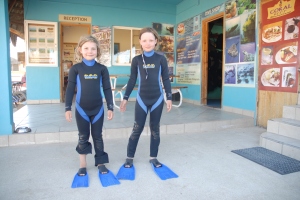
After watching me pull these things on for years for open water swims, the ladies finally get suits of their own…
And then, after a short walk down to the beach, we were on the water and making our way toward Playa La Serinita, one of the smallish beaches on the point north of Los Frailes and our first stop on the reef. Interestingly, the coral reef here is the only living reef in the Baja or anywhere close and it is very young (in reef terms), a juvenile at just 20,000 years.
There was a coral reef in Costa Rica until, with sad predictability, it was completely depleted thanks to overfishing, harvesting coral, clumsy tourism, and people in general doing everything they could to make a hash of it, and it is now dead.
The reef here is a National Marine Park and has been protected since 1995. Claudio told us that since its inception, the Marine Park has seen an overall increase in biomass of 400%, and pointed out areas where experimentation with coral farming was taking place.
Enforcement is, as is always the case, the suzerain issue – policing an open ocean isn’t easy, and illegal fishing is frankly going to happen when you’ve got a resource like this parked next to an economically challenged local population.
A lesson learned in person for us, as several nights ago, while camped at Los Failes, Val and I watched as a suspiciously large boat (The Condor, running under a Mexican flag for anyone in the marine enforcement business who might be curious) parked itself inside the clearly indicated boundary of the marine park, waited until dark, turned a spotlight onto the surface of the water, and spent the next four hours fishing away on the reef that we had been snorkeling on just that afternoon.
At sunrise the boat fired up its diesel engines and left, and it was upsetting to watch it all happen, encumbered as we were by a sense of powerlessness – it was akin to being forced to watch your neighbor’s home getting robbed with your hands tied, unable to do a thing about it.
***
We arrived at mermaid beach for a tour of the reef closest to shore. A couple from Switzerland jumped off the boat, and then it was the girls’ turn. I was initially a little concerned that the ladies, as comfortable as they were in the water of the bay, might have a little more difficulty with the idea of jumping out of a boat, but they pretty much vaulted over the gunwales and began their signature hooting and hollering through their snorkels as parrot fish, wrasses, angels and coronet fish drifted in and out of view.
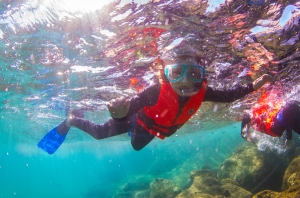
Leonie, seen here in her native habitat, with no real interest in being too close to either mom or dad…
Claudio kept an eye on them without being obtrusive, edging in to escort them away from rocks, or to reign them in if they started off too far away from the group. We spent half an hour or so lazily floating about – between the saltwater, the wetsuit, and the life jacket required by the park, we were all bobbing about like corks – it was back into the boat to go visit the sea lions.
We rounded the point southward toward Los Frailes, and shortly, on a series of enormous boulders that were maybe ten meters offshore and half submerged in the surf, a collection of sea lions came into view, sunning themselves and barking back and forth at each other.
The girls are no strangers to sea lions, certainly, as one of the benefits of living a ten minute walk away from the Brooklyn Zoo was wandering over on many afternoons to see them getting fed.
But the sight of dozens of them, barking away at us, perched on a rock right in front of us, captured them. Claudio signaled us into the water after giving us brief, common-sense instructions: don’t panic, don’t be aggressive, simply float, and thanks to their natural curiosity they will likely come to visit you.
Over the side of the boat we went and looked down to see the rocky bottom falling quickly away from the shore, and we found ourselves in about 30 or 40 feet of perfectly clear blue water, with schools of tropicals coming out to inspect us and more spectacularly, large and luminous parrotfish, and a pair of big snappers moving in from the deep. Sure enough, after a few moments, about five or six of the sea lions, a mix of adults and juveniles, rolled into the water to inspect us.
Just as Claudio had suggested they might , the sea lions as a group swam underneath us, slowly moving closer and closer and examining these odd, buoyant visitors to their home.
The girls were stunned into silence, quite literally the first time that has ever happened, as the sea lions swam, twisting and writhing with extraordinary agility around the rocks and around us, dark and curious eyes on us, and then retreated into the blue depths just beyond our visibility.
Then they would return, led by the smallest and thus youngest, curiosity trumping caution in animals and humans alike. We drank them in, rolling in the swell and taking our eyes off them just long enough to look at the corals, the schools of fish, and the fingers of light playing of the huge bouldered slope that comprised the bottom.
The girls had finally had their fill of this particular feast for the senses, and so Claudio helped them back up and into the boat and Val fed them some granola bars and I pulled myself up the ladder.
On our way back Claudio asked if we were in a rush, a funny question on the face of it (really, who gets into a boat in Cabo Pulmo and is in a rush) and when all of us said no, he took us out to one of the deeper fingers of the reef, hoping to spot a school of jacks, some mobula rays, or perhaps a whale.
None of these particular species were cooperating at this point, but the reef below the boat was so lovely that Claudio waved us back in to have a look around. The girls, midway though their granola bars, decided to sit this one out, so I pulled on my flippers and dropped backward over the boat, scuba-style, to follow Val.
Bobbing to the top and orienting myself, I cleared my snorkel and looked down below me.
Maybe twenty feet below, working its way along a seam in the reef, swam a shark that quite clearly was bigger than I was, perhaps by a factor of two.
When you’re sharing open water with them, any shark is a big shark, but Claudio later confirmed my guess at the size – he figured it was at least ten feet long. Sharks move like sharks, too, which is to say they almost wind their way through the water like a snake does over land, all curves and meanace, and this one was moving slowly but somehow at the same time in a way that communicated power and an enormous potential for speed, head searching right to left and back again, a toothy pendulum in perpetual motion, looking for its next meal.
Not in a rush to take my eyes off it, I watched as it swam toward Val, and then watched as another equally large shark followed the same path. I popped my head above the water and called out to Claudio.
“Ah, Claudio, there is a really big shark down here. Two of them.”
“Great! You’re so lucky! I think it’s maybe a bull shark!”
I processed this, trying to remember if bull shark meant horrible danger, or benign friend.
I located Val, who I guessed had seen the sharks too, because she abruptly halted, turned around and swam at pace back to the boat.
Simultaneously, the girls, having heard that there were sharks in the water, threw down their granola bars and hauled on their masks, and announced they were going in, and jumped into the water beside Val, and then promptly swam out to me and demanded to know where the sharks were.
We held hands, floating in a group, my eyes up to check on the boat (close) and back down, searching, looking for either of the two sharks.
They didn’t return, uninterested and uninspired by us, and we didn’t see them again.
With the ocean current we drifted back along the reef with virtually no energy expended, and watched the curtain of fish, dozens of species and sizes and colors, that waved gently just at the reef’s edge, waiting for the deep, cool currents to deliver their next meal.
Finally, it was back in the boat to call it a day.
At the dive center, while the girls peeled out of their wetsuits and played in the pool (ostensibly there for scuba instruction) Claudio took the opportunity to brag to the scuba divers who had gone out looking for sharks that his snorkel team had seen two of them, and they were big.
For my part, I took a warm, freshwater shower – my first in over a week – and then stopped by the office to thank Claudio for the day, and having made the suggestion in the first place. It was an enormous success, the girls had enjoyed themselves tremendously, and the chance to see the sea lions and swim with them, not to mention the chance encounter with the shark, was exceptional.
***
As we drove back to Los Frailes, with the girls chirping away about how terrific the day was, and how their sole disappointment was not seeing a shark, it let to me thinking that night about how desperately I hope the tourism model can provide enough to replace the ocean harvesting model currently in place here, and fisheries the world over.
Here’s the thing: the girls have seen sharks on this trip, indeed, on the very beach we have set up our camp at. There’s a fish camp just outside the border of the Marine Reserve here, and the pescadores fish for sharks. We happened past their pangas one afternoon as they were cleaning their catch, five mako between five and eight feet long, and the girls were rapt by the sight of these exquisite animals, still shimmering blue in the sunshine and lined up on the beach, and their attention was held as the fishermen efficiently and expertly butchered them.
One of the sharks, as it turns out, was a female, and was gestating within her a brood of maybe a dozen babies, and they spilled out of her belly and Val caught her hand to her mouth and my jaw clenched and I kept watch on the girls, wondering what the sight of this would mean to them.
The fishermen threw the dead babies, each a sliver of a shark, eight or ten inches long, into the surf where the assembled gulls, pelicans and frigate birds fought for them. The girls watched this, and then continued watching as the skins were cut away, the fins sliced from the bodies, the jaws were cut from the heads, and the meat was filleted from the bone.
Val could not stand to watch but the girls wouldn’t leave, so I stayed with them until the fishermen were all done.
Shark here is anywhere from three or four times the price of just about any other fish, and it was being prepared to send to town because, according to the fishemen, Americans and Canadians like it.
Really, then, it’s us who doom the species.
There are too many of us who are afraid to jump in the water with these animals and simply watch them, alive and moving, and derive our pleasure from them that way, rather than having their meat delivered to us in a restaurant.
It’s hard to even imagine that the satisfaction derived from eating them could possibly equal the absolute, visceral thrill of seeing them in open water.
And, we export our conscience, too – to be sure, it’s not the first-world shark aficionado who has to throw a dozen dead baby sharks into the sea before he has the opportunity to eat his meal.
That’s left up to the pescador at Los Frailes, who is only being a rational economic actor, feeding his family the way it has been done for generations.
The shark, of course, is also enjoying the unwelcome attention of the pescadors because of the enormous depletion of the other species here that would have, at some point, been so much more desirable – the big tuna, marlins, fat dorados and others that have simply disappeared altogether.
The harvesting of these resources has clearly not happened in any kind of sustainable way. A visit to the onetime angler’s haven of Bahia de Los Angeles, years ago the penultimate stop for the big game fisherman, revealed to Val and myself a sad collection of shuttered RV parks without so much as a cash machine in town – suggested what once was and, had behaviors been different, what might still be.
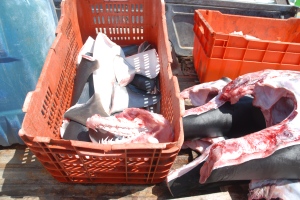
An extraordinary animal reduced to bins of parts, and it was very difficult not to feel quite emotional about it.
What to do?
There has to be some way to make it more worthwhile to the fisherman to leave those makos in the water than to drag them ashore, half a dozen at a time, to be butchered on the beach. He’s a small guy anyway, God knows what is happening out there on the big commercial boats with their sonar and gill nets and whatever other absurd advantages we can employ over this fish.
I would expect that part of it is connecting ourselves (maybe re-connecting ourselves) with the world we live in, a process which itself forces a closer examination of our actions and their consequences. Getting the girls out into the world itself, with all of its hard choices and difficult compromises and unvarnished truths is part of it, too.
They know they want to get right back into the boat and have Claudio show them some sharks, alive, prowling the bottom of the reef.
If a generation or two of us felt that way, we’d surely be better off.
I do know that if and when the girls bring their kids back here in thirty years or whatever it is, I can only hope that they’ll have the luxury on a day with low winds and calm waters to be able to flop out of a boat, get their bearings, look down and, unexpectedly, see a shark as big as they are.
***
Note: I must credit Claudio for taking the pictures here which clearly involved a camera and water… on top of being a great guide, and keeping everyone safe, he is an excellent photographer.
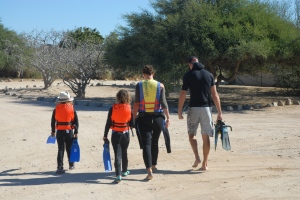
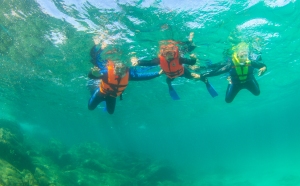
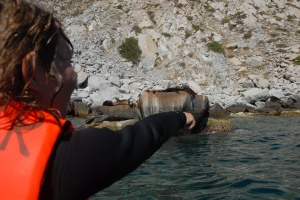
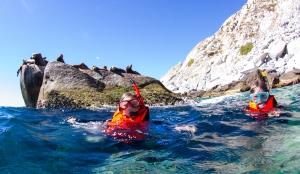
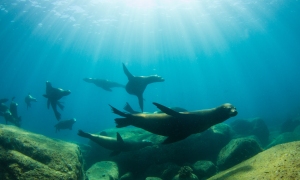
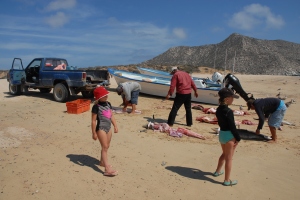
Ahhh the adventurous Goffins! We love you guys and miss you dearly. The way you are feelin’ the demise of the sharkies, I feel about the butchering of cows, or chickens, or fish, or sheep or whatever other petting zoo friends we eat! I remember when we were in the Bahamas, we saw guys catching small sharks and just walking off the beach with the sharks still thrashing, thrown over their shoulder. I’m afraid once we understand the plight of any mistreated/hunted/poached animal, it’s impossible to “unsee” that danger.
Greetings, dear friends; it’s been way too long since our sad yet sated farewell (almost five weeks ago) and much too long since i’ve reached out. I’ve been home for about three weeks and it feels like i’m just beginning to focus my heart and mind on my life and work; to be sure, i’ve been puttering and quasi productive, but memories of baja and the desert southwest still regularly occupy my thoughts and dreams. Last nite and this morning i caught up on your adventures and it literally brought tears to my eyes… your white-knuckle description of the windstorm at agua verde was sharply suspenseful and vividly accounted, while true to form, humorous as well… We of course can all appreciate the redemptive nature of the story and the place,… ahhh, baja, the power and the beauty, so wild! I can’t say enough how delightful it is to continue to follow your adventures vicariously thru the “intertubes”, truly and thoroughly loving it,… your writing style, astutely observant and comedically delivered, mimics so well your real-life persona(s), that mixed with the fond and adoring memories, for me your prose truly comes alive, vivid, and real, it touches this boys heart, as well as stirs up a bit of that ugly emotion, envy. Man o man, who woulda thunk that a month in Baja is simply too damned short! I especially loved your musings and reflections on the sad state of affairs wrought by humans upon baja’s ecosystems and all things wild the world over… my takeaway from this and every heartwrenching destruction of our natural ecosystems is that once you strip away the economics, the inequality, the decadence of the wealthy and elite juxtaposed to abject poverty, and all the other cultural morays that may dictate what we eat, there is simply far far too many of us. Sigh. I’m praying and fighting for the hope that there will be some wilderness left, if and when, we as a species get our shit together. We (Steph, Abbie, myself) love you guys dearly and if yer still running with Alex and Ashek, please give them our love as well;, we really really miss y’all and we hope to see you up Oregon way sometime in the future.
Beautiful and thought provoking – thank you. I am loving seeing the world through the eyes of the Goffin family.